Medical expenditures for colorectal cancer diagnosis and treatment:A 10-year high-level-hospital-based multicenter retrospective survey in China,2002-2011
Jufang Shi ,Guoxiang Liu ,Hong Wang,Ayan Mao,Chengcheng Liu,Lanwei Guo4,,Huiyao Huang,Jiansong Ren,Xianzhen Liao,Yana Bai,Xiaojie Sun,Xinyu Zhu,,Jialin Wang,Bingbing Song,Jinyi Zhou0,Lin Zhu,Haike Lei2,Yuqin Liu,Yunyong Liu4,Lingbin Du,Yutong He,Kai Zhang,Ni Li,Wanqing Chen,Min Dai,Jie He
1Office of Cancer Screening,National Cancer Center/National Clinical Research Center for Cancer/Cancer Hospital,Chinese Academy of Medical Sciences and Peking Union Medical College,Beijing 100021,China;2Department of Health Economics,School of Health Management/Public Health,Harbin Medical University,Harbin 150081,China;3Office of Public Health Strategic Information,Institute of Medical Information,Chinese Academy of Medical Sciences,Beijing 100020,China;4Department of Cancer Epidemiology,Henan Office for Cancer Control and Research,The Affiliated Cancer Hospital of Zhengzhou University,Henan Cancer Hospital,Zhengzhou 450008,China;5Hunan Office for Cancer Control and Research,Hunan Provincial Cancer Hospital,Changsha 410006,China;6Institute of Epidemiology and Health Statistics,Lanzhou University,Lanzhou 730000,China;7Center for Health Management and Policy,Key Lab of Health Economics and Policy,Shandong University,Jinan 250012,China;8Department of Public Health,Shandong Cancer Hospital Affiliated to Shandong University,Jinan 250117,China;9Heilongjiang Office for Cancer Control and Research,Affiliated Cancer Hospital of Harbin Medical University,Harbin 150081,China;10Institute of Chronic Non-communicable Diseases Prevention and Control,Jiangsu Provincial Center for Disease Control and Prevention,Nanjing 210009,China;11Teaching and Research Department,Affiliated Cancer Hospital of Xinjiang Medical University,Urumqi 830011,China;12Department of Cancer Research and Control Office,Chongqing University Cancer Hospital,Chongqing 400030,China;13Cancer Epidemiology Research Center,Gansu Provincial Cancer Hospital,Lanzhou 730050,China;14Cancer Prevention and Control Office of Liaoning Province,Cancer Hospital of China Medical University,Liaoning Cancer Hospital and Institute,Shenyang 110042,China;15Department of Cancer Prevention,Cancer Hospital of the University of Chinese Academy of Sciences,Hangzhou 310022,China;16Cancer Institute,The Fourth Affiliated Hospital of Hebei Medical University,Shijiazhuang 050011,China;17Department of Thoracic Surgery,National Cancer Center/Cancer Hospital,Chinese Academy of Medical Sciences and Peking Union Medical College,Beijing 100021,China
Abstract Objective:Colorectal cancer(CRC)causes a substantial burden of disease in China and the evidence of economic burden triggered is fundamental for priority setting.The aim of this survey was to quantify medical expenditures and the time trends for CRC diagnosis and treatment in China.Methods:From 2012 to 2014,a hospital-based multicenter retrospective survey was conducted in 13 provinces across China.For each eligible CRC patient diagnosed from 2002 to 2011,clinical information and expenditure data were extracted using a uniform questionnaire.All expenditure data were reported in Chinese Yuan(CNY)using 2011 values.Results:Of the 14,536 CRC patients included,the average age at diagnosis was 58.2 years and 15.8% were stage-I cases.The average medical expenditure per patient was estimated at 37,902 CNY[95 % confidence interval(95%CI):37,282-38,522],and the annual average increase rate was 9.2% from 2002 to 2011(P for trend<0.001),with a cumulative increase of 2.4 times(from 23,275 CNY to 56,010 CNY).The expenditure per patient in stages I,II,III and IV were 31,698 CNY,37,067 CNY,38,918 CNY and 42,614 CNY,respectively(P<0.001).Expenditure significantly differed within various subgroups.Expenses for drugs contributed the largest proportion(52.6%).Conclusions:These conservative estimates illustrated that medical expenditures for CRC diagnosis and treatment in tertiary hospitals in China were substantial and increased rapidly over the 10 years,with drugs continually being the main expense by 2011.Relatively,medical expenditures are lower for CRC in the earlier stages.These findings will facilitate the economic evaluation of CRC prevention and control in China.
Keywords:Colorectal neoplasms;health expenditures;diagnosis;therapeutics;China
Introduction
Colorectal cancer(CRC)is associated with a substantial burden of disease in China;the age-standardized incidence rate was 18.05 per 100,000(1)and the numbers of new cases and deaths in 2015 were estimated at 4,292,000 and 2,814,000,respectively(2).Like the western pattern,it has been suggested that the burden of CRC in China will continue increasing,mainly due to the population aging,in the absence of any local population-based prevention and control programs.
Although more than twenty countries worldwide have conducted population-based CRC screening at regional and national levels,to date,no national CRC screening program has been established in mainland China.The central government of China initiated a demonstration program on CRC screening in selected rural areas in 2006 and that was extended to urban populations in 2012(3-4).Health economic evidence was required by local policymakers to further scale up CRC screening and related intervention programs,but these remain limited(5).To evaluate the cost-effectiveness and budget impact of CRC screening at the population level,it is necessary to collect related expenditure or cost data of CRC patients in advance.Moreover,mastering the trajectories of medical expenditures and their composition can help explain the efficiency of the current health-care reform policy on cost control and thus facilitate the development of optimal policies.
A systematic review conducted by the research team found that the information on expenditures per cancer patient in China was limited and most of the included studies were single-center based on relatively small sample sizes(6).It seems that previous estimates of medical expenditures per CRC patient likely underestimated the real economic burden of CRC(7).Thus,as a part of the Cancer Screening Program in Urban China(CanSPUC)initiated in August 2012 and supported by the central government(8),a large sample multi-center survey was conducted to estimate the medical expenditures for CRC diagnosis and treatment in China,and to measure the economic burden of CRC at an individual level.
Materials and methods
Study design
This hospital-based multicenter retrospective survey,from a health care service provider’s perspective,was conducted from 2012 to 2014.Information on primary CRC patients treated from 2002 to 2011 was abstracted via medical charts and a review of hospital billing records.The survey encompassed 36 hospitals(21 general hospitals and 15 specialized hospitals)across 22 cities in 13 provinces or municipalities in China.Further information for each study site,including population size,gross domestic product(GDP)per capita,city involved,and the levels of the involved hospitals,are provided inSupplementary Table S1.The current survey was approved by the Institutional Review Board of the Cancer Hospital at the Chinese Academy of Medical Sciences.
Survey participants
The inclusion criteria mainly included the following:1)clinically confirmed primary CRC patients(cases with two or more primary cancers were excluded);2)the discharge date of the last treatment or clinical visit was between January 1,2002,and December 31,2011;3)patients obtained major treatment at designated hospitals(cases that received only a diagnosis or posttreatment follow-up were excluded);and 4)basic personal,clinical(including staging and treatment details),and expenditure data were available.
Sample size and data abstraction
Each site was required to select 1,200 cases from 2002 to 2011(120 cases each calendar year).Based on the discharge date of the last treatment or clinical visit at each study hospital,the first patient diagnosed at December 31 of the year was enrolled,then continually walked back case by case until 120 eligible cases were obtained.A few hospitals enrolled all the cases in the calendar year when the number of available cases was less than the protocol required.Early-stage CRC patients are much less common in hospitals in China in the absence of population-based CRC screening.A similar situation also occurs with female CRC patients based on the cancer registry data.Thus,in order to obtain sufficient sample sizes for these two subgroups,in our detailed operation manual of the survey,the proportion of eligible cases were required to reach about 25% for each clinical stage(I-IV)but no more than 67% for the male cases.Based on the exclusion criteria,3,034 non-eligible cases were excluded from 17,702 patients enrolled initially.For all of the eligible cases,detailed information abstracted mainly included the following:1)basic personal information,including name,hospital ID,gender,age,end date of last clinical visit,etc.;2)clinical information,such as staging(clinical staging and/or TNM staging),pathologic diagnosis,main diagnosis,and confirmation date;and 3)expenditure data by clinical visit,including the start date of each visit,outpatient or inpatient,number of inpatient days,main treatment options,co-morbidity,complications,overall expenditures(both of out-of-pocket payments and insurance reimbursement and any spending identified in the medical records),any medicine/drug expenditures and other item-specific expenses.To ideally capture the“full-course”expenditures data for each individual patient,a time window was not specified and could be different among patients.If patients received other CRC-related treatments from another hospital within the same year,the corresponding expenditure data incurred could not be captured due to the limited budget.All the abstraction forms were checked by a second research staff for quality control.
Data management and analysis
EpiData software(Version 3.1;The EpiData Association,Odense,Denmark)and SAS software(Version 9.3;SAS Institute Inc.,Cary,NC,USA)were applied for data entry,management and analysis.When data were missing from any variables such as the date of discharge,date of diagnosis,overall medical expenditures,starting date of treatment or information on the number of inpatient days,the records were excluded from the current analysis(132 more eligible cases were excluded from the current analysis due to this data missing issue).A few records with outlier expenditure values were also excluded according to the clinical experts’opinions.
All the expenditure data were reported in Chinese Yuan(CNY)using 2011 value,inflated using year-specific health care Consumer Price Index(CPI)of China(exchange rate:1 CNY=0.158 USD).The expenditure data were reported asand Student’st-test,analysis of variance(ANOVA)and the SNK-test method were then used after the logarithm transition for different comparisons.An indicator of average Tempo was used to calculate the annual growth rate of medical expenditure per patient/clinical visit/day from 2002 to 2011.A subgroup analysis of the medical expenditures per patient and their time trends was also conducted by survey site,region,hospital type,hospital level,number of clinical visits,age group,pathological type,clinical stage,or therapy type.More specifically,the concept of“region”in China was based on the classification of the China Health Statistics Yearbook 2012 as follow:east(Beijing,Hebei,Liaoning,Shandong,Guangdong,Jiangsu,and Zhejiang),central(Heilongjiang,Hunan,and Henan),and west(Chongqing,Gansu,and Xinjiang).The concept of“hospital level”was divided into“tertiary A”(the highest)and“tertiary B or less”,which were certified by the local governments.
In addition,a one-way sensitivity analysis by survey site was also performed considering the presence of heterogeneity.All the statistical tests were two-sided and P values less than 0.05 were considered statistically significant.
Results
Patient characteristics
A total of 14,668 records of CRC patients were abstracted,and 14,536 were included in the current analysis,almost all were from tertiary-level hospitals.The average age at diagnosis was 58.2±13.3 years and 57.3% of the subjects were males.Adenocarcinoma was listed as the most common pathological type(86.4%).The median number of clinical visits per patient was 1(P5-P95:1-7).The patients included spent a median of 26 days hospitalized for cancer treatment(P5-P95:17-44).Most of the therapy regimens involved were surgery alone(42.6%),surgery combined with chemotherapy(28.7%)and chemotherapy alone(13.6%)(Table 1).
In general,stage I CRC patients accounted for 15.8% of the total,which was less than the expected.Larger proportion of late-stage(IV)patients among all patients in western region were diagnosed(33.6%),compared with the proportions in eastern and central regions(both less than<21%).It was also observed that surgery-related treatment was more commonly provided to early-stage patients(as expected):among all patients received surgery treatment alone(n=5,524)or surgery combined with chemotherapy(n=3,900),59.9% and 46.5% were diagnosed in stage I or stage II;on the contrary,among the all treated by radiotherapy alone(n=425)or by chemotherapy alone(n=1,779),more than 69% were diagnosed in late-stages(III-IV).
Overall and subgroup analysis of medical expenditures per patient
The overall average medical expenditures per patient for CRC diagnosis and treatment from 2002 to 2011 were estimated at 37,902 CNY[95 % confidence interval(95%CI):37,282-38,522],of which 91.6%(34,718 CNY)occurred from two months prior through ten months after the date of diagnosis(the newly diagnosed course).To reflect the economic burden of CRC in very recent years,Table 2also presents expenditure values during 2009-2011(more stable using the aggregated data for three years),which was 48,163 CNY(95% CI:46,794-49,533).
The average expenditures per CRC patient increased as the cancer progressed.Medical expenditures for CRC at stages I,II,III,and IV were estimated at 31,698 CNY(95% CI:30,677-32,719),37,067 CNY(95% CI:36,156-37,979),38,918 CNY(95% CI:37,865-39,971)and 42,614 CNY(95% CI:40,595-44,634),respectively(P for trend<0.001).It was also observed that medical expenditures per patient during 2002-2011 rose as the number of clinical visits increased,from 25,743 CNY for 1 visit to 74,947 CNY for 4 or more visits.Among the patients who received different types of therapy,medical expenditures for those who received palliative care were the lowest(12,565 CNY),while those for patients who received surgery followed by radiotherapy were the highest(56,087 CNY).The expenditures per CRC patient also significantlyvaried within many other subgroups,including region(eastvs.west:1.4 times,and centralvs.west:1.2 times),hospital types(cancer hospitalvs.general hospital:1.2 times),hospital level(tertiary Avs.tertiary A less:1.8 times),pathological types(adenocarcinomavs.others:1.6 times)and gender(malevs.female:1.1 times).There were no significant differences among different age groups.Table 2contains further information on the subgroup analysis results.
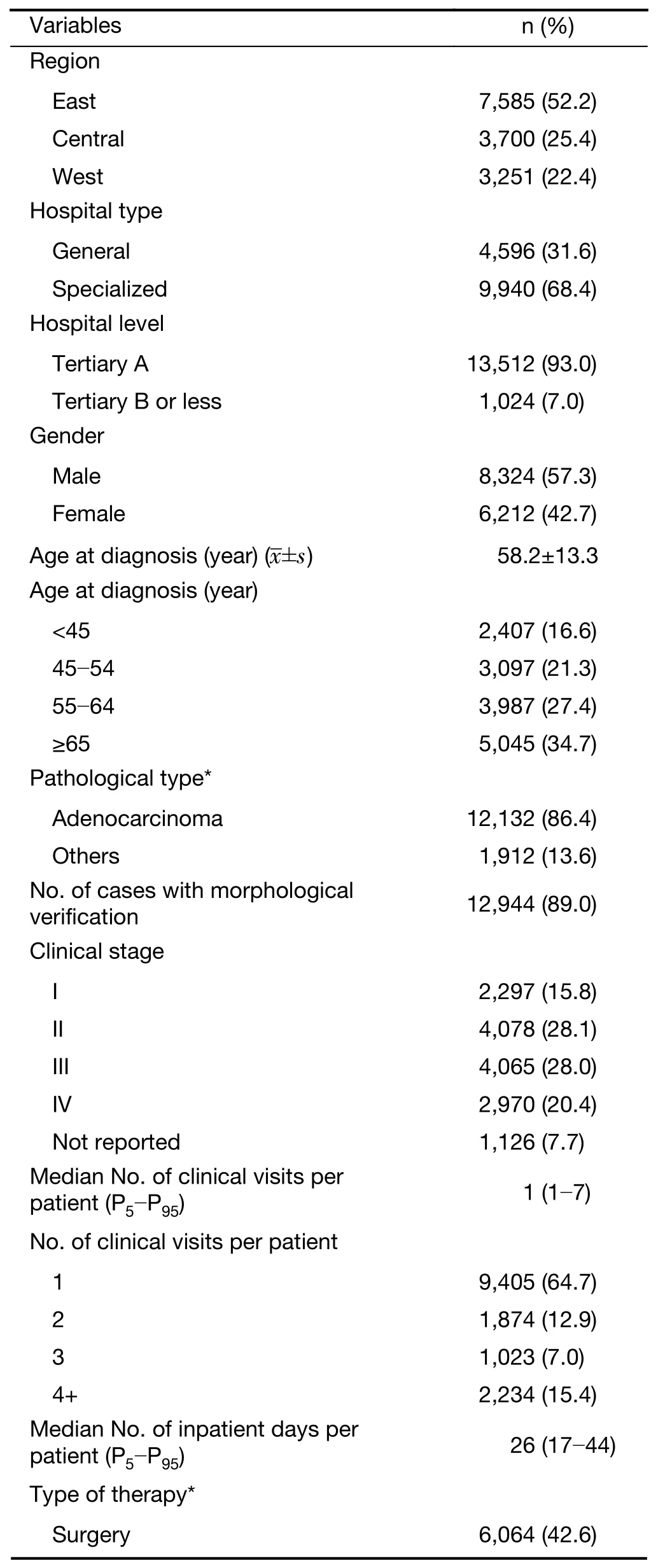
Table 1 Characteristics of colorectal cancer patients included,2002-2011(N=14,536)
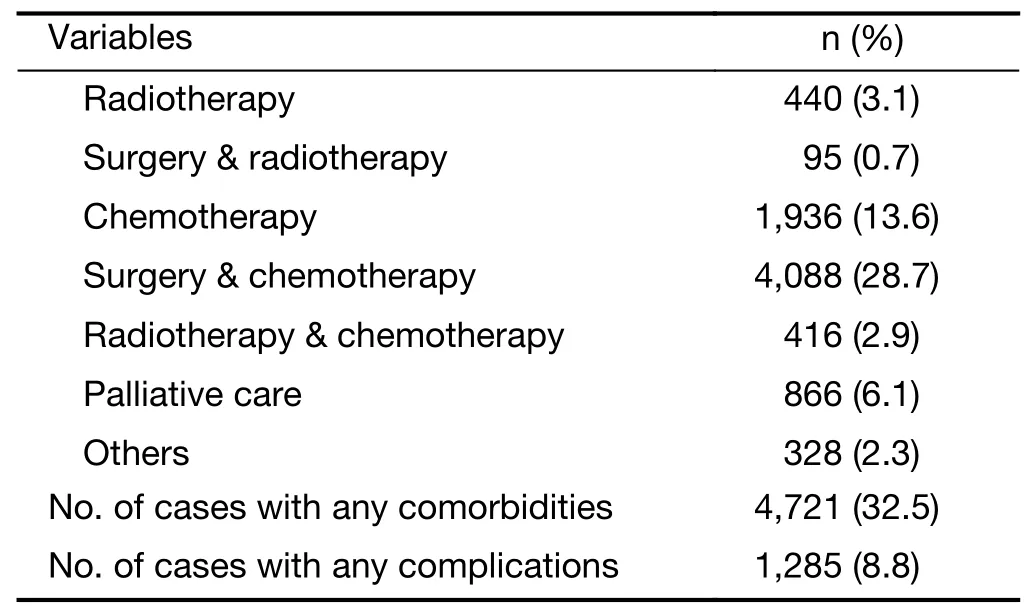
Table 1 (continued)
Time trend analysis of medical expenditures and related factors
The per-patient medical expenditures increased from 23,275 CNY in 2002 to 56,010 CNY in 2011(2.4 times),and the annual growth rate was estimated at 9.2% over the 10 years,with 8.8% during 2002-2008 and 10.5% during 2009-2011.Growth trends were also observed in the number of clinical visits per patient(9.9% over the 10 years,11.6% during 2002-2008,and 17.8% during 2009-2011),the number of inpatient days per patient(6.1% over the 10 years,7.2% during 2002-2008,and 7.1% during 2009-2011)and the daily average expenditures(3.2% over the 10 years,3.6% during 2002-2008 and 4.6% during 2009-2011).All the P values for trend were less than 0.001.Thus,the continued growth of expenditures per patient might be explained by the increase in daily expenditures and the number of inpatient days per patient,or the increase in clinical visits and relatively stable expenditures per visit(Figure 1).
Regarding to the time trend of subgroup medical expenditure per patient,consistent growing trends could be detected,but the growing patterns and rates were distinct(Figure 2).The increasing patterns of expenditure by four cancer stages remained approximately consistent during 2002-2008 and then differed during 2009-2011.The most obvious increase was observed in the stage IV group.In terms of differences among the therapy types,the expenditures caused by surgical treatment combined with chemotherapy or chemotherapy alone increased substantially and cost more,compared to the other therapy types.Different changes were also observed from 2002 to 2011 within subgroups stratified by region,hospital type,hospital level,numbers of clinical visits,age group,pathological type,cancer clinical stage and therapy type(Figure 2).
For CRC patients in different provinces,the overall expenditures per patient in Guangdong,Beijing,and Shandong were the highest(more than 58,000 CNY per patient),and those of Chongqing,Gansu,and Hebei were the lowest(less than 22,000 CNY per patient)(Figure 3A).An obvious gap in the time trend of expenditures was demonstrated in that both the direction and rate of change differed(Figure 3B).We conducted a sensitivity analysis by separating the study sites into two groups,one in which the number of clinical visits were above the average,including Beijing,Liaoning(Shenyang site),Shandong,Guangdong,Henan,Jiangsu and Xinjiang;the corresponding perpatient medical expenditure has increased to 2.8 times,with an annual average growth rate of 10.9% over the 10 years(from 26,470 CNY in 2002 to 74,442 CNY in 2011)(Figure 3C).
Proportional breakdown of medical expenditures per patient
Within the overall average expenditure per CRC patient,drugs contributed the greatest expense.The average proportion was 52.6% over the 10 years,and only in 2002 this was lower than 50.0%.As the second largest proportion,expenditures on treatment(mainly for radiation and chemotherapy)contributed 12.7% of the overall costs(ranging from 10.2% in 2005 to 14.8% in 2011),followed by operation fees,which accounted for 9.6% of the overall expenses(ranging from 8.4% in 2009 to 19.4% in 2002).Further information on other items can be found inFigure 4.
Discussion
Two recent systematic reviews from our research group found that individual-level evidences of the economic burden of CRC were relatively limited and less comparable
among studies over past 20 years in China,particularly those with long time spans,and the medical expenditures per CRC patient may have been underestimated(6,7).The current survey provides large sample size,multi-center,retrospective evidences on the 10-year time trend of medical expenditures for CRC diagnosis and treatment in China,both of the overall burden and discrepancies among subgroups.
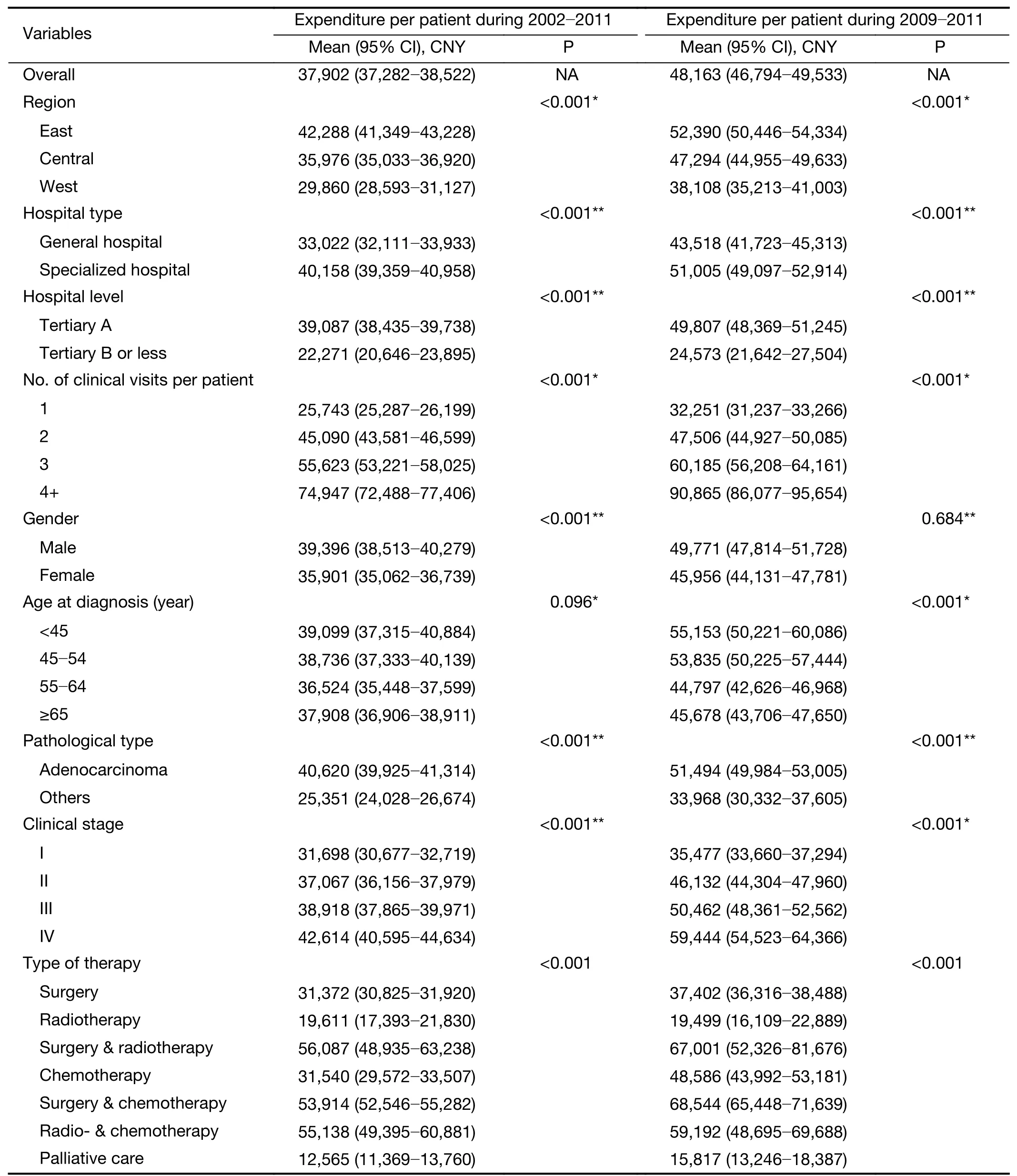
Table 2 Subgroup analysis of medical expenditures for colorectal cancer diagnosis and treatment per patient by time period
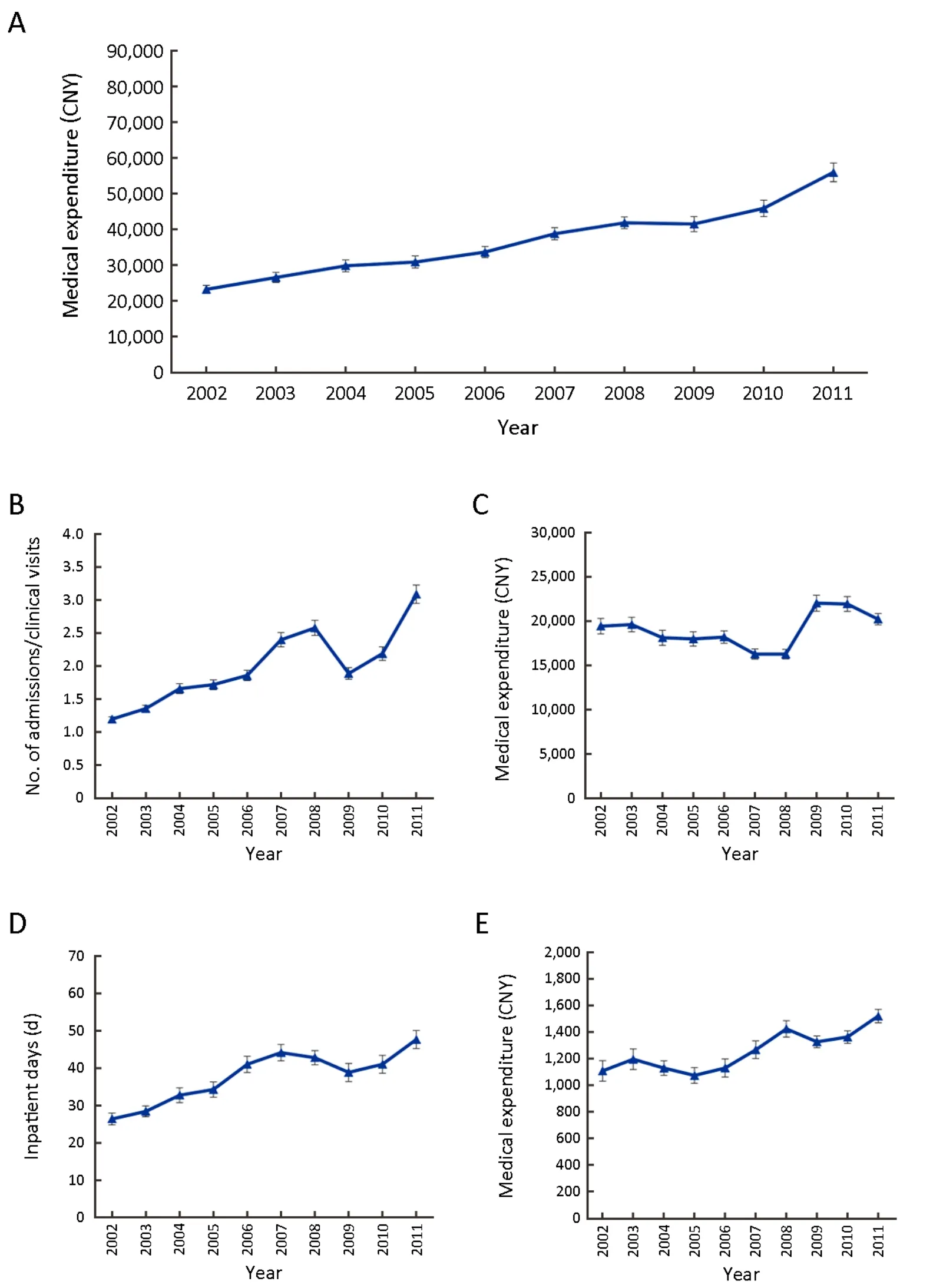
Figure 1 Time trends of expenditures per patient and related factors for colorectal cancer in China,2002-2011.(A)Overall average expenditure per colorectal cancer patient;(B)Number of admissions/clinical visits per patient;(C)Expenditure per clinical visit;(D)Inpatient days per patient;(E)Daily average expenditure per patient.
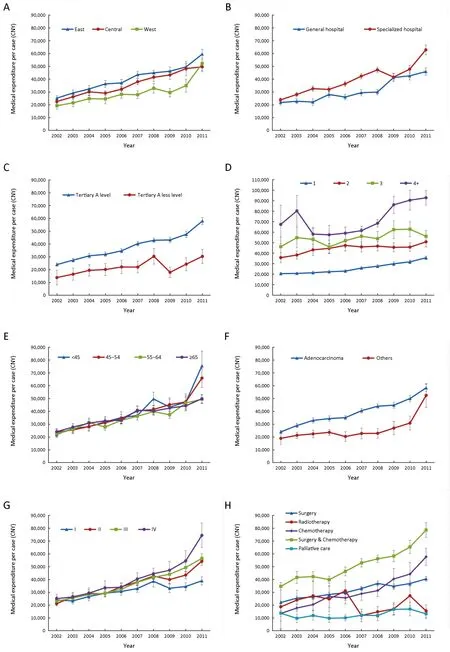
Figure 2 Time trends of expenditures per colorectal cancer patient in China,by subgroups,2002-2011.(A)Region;(B)Hospital type;(C)Hospital level;(D)Number of admissions/clinical visits;(E)Age group(year);(F)Pathological type;(G)Cancer clinical stage;(H)Therapy type.
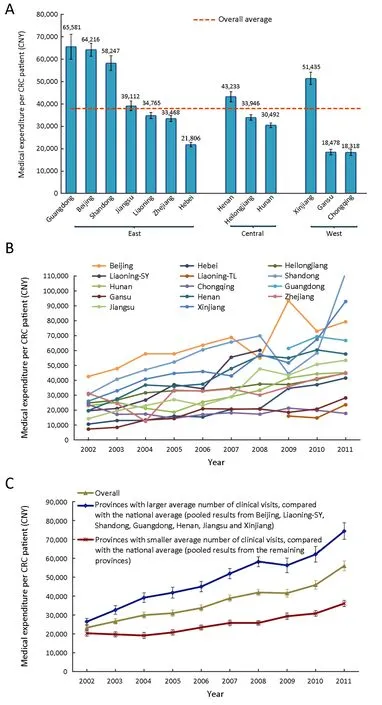
Figure 3 Overall average and time trends of expenditures per colorectal cancer patient in China,by province,2002-2011.(A)Overall expenditure per patient by province/study center;(B)Time trend of medical expenditure per patient by province/study center;(C)Sensitivity analysis for expenditure time trend by number of clinical visits.
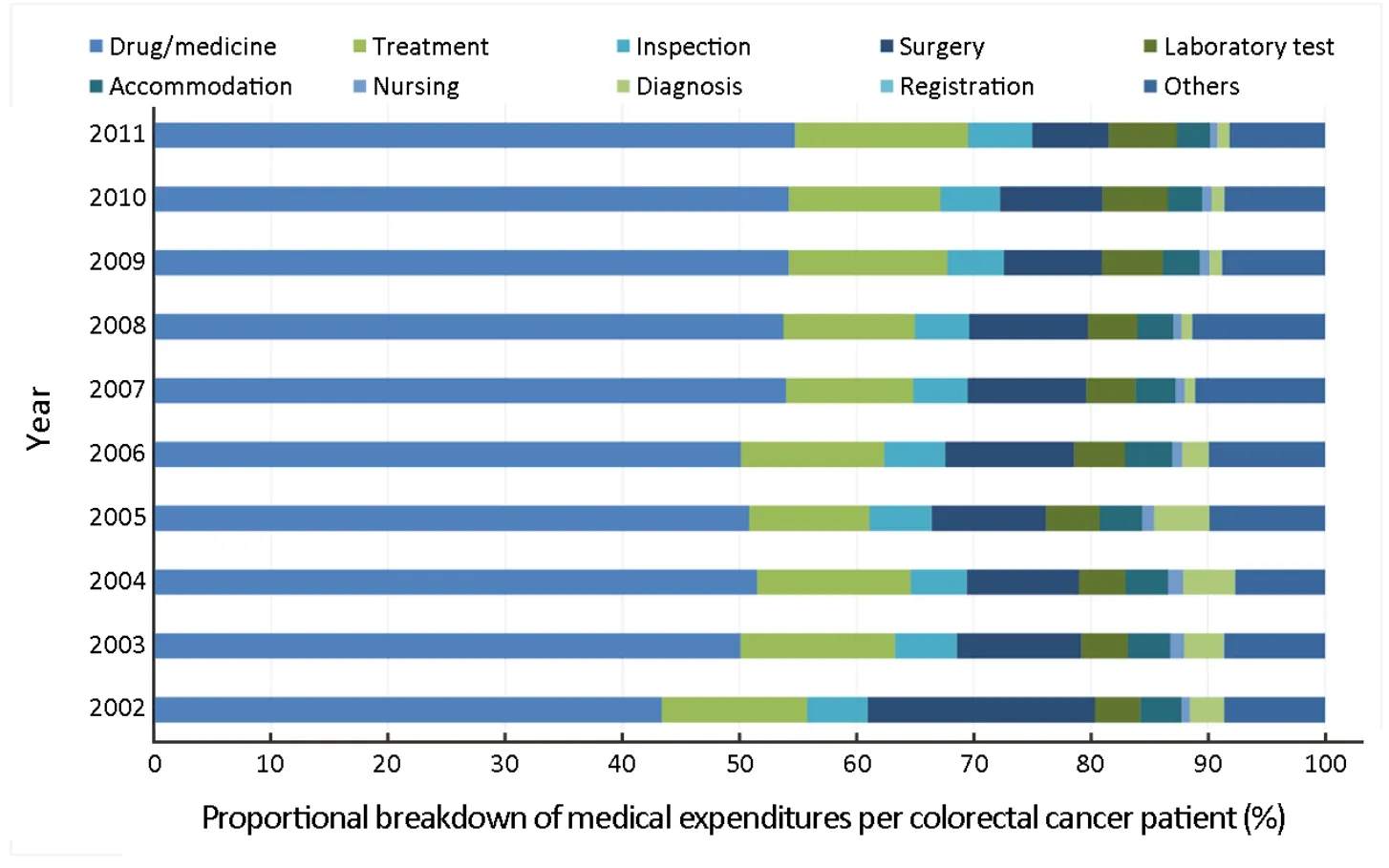
Figure 4 Proportional breakdown of expenditures per colorectal cancer patient in China,2002-2011.
The previously mentioned systematic review included more than 20 studies(mostly single-center surveys,published between 1996 and 2015)and measured the median expenditure per CRC patient as 27,962 CNY with a wide range(9,428-83,320 CNY)(7);the correspondingly measured 37,902 CNY(95% CI:37,282-38,522)from the current multi-center survey seems more representative and robust.Another multi-center survey on CRC expenditure published in 2017 by our research team,focused on patients diagnosed more recently(2012-2014),using faceto-face interviews(rather than medical record abstraction),and was designed to capture not only medical expenditures but also non-medical expenditures(5).The consequent estimate of medical expenditures per CRC patient of 61,859 CNY(5)was higher than the findings from the current retrospective survey,mainly due to the different approaches(complementing each other)applied and the period covered.The above comparison was concerned with the absolute burden estimates within the local population.When compared the relative burden of this survey with other countries,we found that the 12-month expenditure(34,718 CNY)occurred to the newly diagnosed course was 0.96 times the GDP per capita in China in 2011(36,018 CNY),which is much higher than the corresponding value of less than 0.6 in the United States(from 2008 to 2010)(9,10).This comparison implies that the economic burden of CRC diagnosis and treatment was relatively greater for CRC patients in China.
Unsurprisingly,spending on medicine/drugs was the largest source of the overall expenditures(averaging 52.6%)and increased by calendar year,although the local government initiated a health care reform to reduce the prices of the medications on essential drug lists in 2009(11).This was not a CRC-or cancer-specific situation,but more common for the entire medical industry in China.Based on the China Statistics Yearbook 2011,the general percentage of drugs in the total health expenditures was 44.6%(12),while that of the Organization for Economic Cooperation and Development(OECD)countries was as low as a fifth of all health spending on average(13).Chinese public hospitals were an embodiment of joint action from both government and market(11).On the one hand,the government set fee schedules attempting to regulate the medical market;for example,doctor consultation services charged less than the real costs but those using more modern medical technologies charged more.On the other hand,public hospitals had to maintain financial balance and could charge about 15% mark-up on medicine/drugs.This long-term trend could be diminished and more substantial decreases in the proportion of drug expenses are anticipated.
This survey revealed that medical expenditures for CRC in China more than doubled over the 10-year period.The estimated annual average increase rate of 9.2% was slightly higher but comparable to the finding from a systematic review of expenditure per CRC patient in China over 20 years,which was 6.9%(6,7).Extending the comparison to other populations,we found that expenditure grew more rapidly;for example,the total direct cost per cancer case increased at an annual rate of 3.0% during 2008-2011 in the United States(14).In addition,the expenditure annual increase was more substantial during 2009-2011 than that during earlier period of 2002-2008.The observed increase in health care expenditure over a long-term horizon might be because of the development of medicine and the continuous emergence of new drugs.However,it is unclear if this induced demand for cancer health care was a consequence of China’s health care reform initiated in 2009,which aimed to increase health insurance coverage(11).
Our findings that the expenditures per patient increased along with the clinical stage are consistent with the staging pattern shown in a micro-costing study in Hong Kong,China,in which the direct cost from stages I-IV were estimated at $17;071,$19;755,$26;883,and $45;115,respectively(15).In addition,the proportion of stage I patients in the current survey(15.8%)was lower than the originally targeted 25.0%-30.0%,even with much additional effort.This suggests that,in the absence of routine CRC screening,most CRC patients in China are diagnosed at very late stages.These facts imply that an intervention program might be cost-effective if more patients could be detected and treated at an early cancer stage or in the precancerous phase,but comprehensive study needs to be done to provide explicit evidence in costeffectiveness.
The medical expenditure observed in the eastern region were higher than that in the central and western regions,broadly mirroring the heterogeneity of economic development among the three regions of China.The differences among study hospitals,with a 3-time-gap between the highest(Guangdong in the east)and the lowest(Chongqing in the west),could have been caused by some other potential heterogeneities among each individual hospitals,including the average number of admissions/clinical visits of the included patients,and the strength of quality control in data abstraction process.
Expenditure comparison among some of the other subgroups provides further information.1)Hospital types:greater expenditure occurred in specialized hospitals(compared to general hospitals),which might be due to more standardized clinical procedures in CRC diagnosis and treatment.2)Pathological types:the expenditure difference between the pathological types was likely due to the availability of more therapy options and also more standardized procedures in adenocarcinoma CRC(compared to other non-adenocarcinoma CRC).3)Therapy types:spending widely differed among the various therapy subgroups,but it is unclear why radiotherapy expenses decreased only after 2006.In addition,our study collected smaller sample of patients who received radiotherapy only compared to the size of the subgroups who underwent surgery and chemotherapy.This somewhat echoes a routine clinical practice that radiotherapy is recommended only for rectal cancer patients but not for colon cancer patients.
The current analysis has several limitations.Firstly,considering the feasibility and complexity of the field implementation,the survey did not apply a random sampling approach,which potentially affected the representativeness of the results.Secondly,although generally higher than the previous estimates included in the systematic review,the current findings on expenditures per CRC patient likely underestimated the economic burden of CRC in China for two reasons:1)The survey abstracted only the expenditure data within the survey hospitals;however,theoretically,some of the CRC patients also received diagnosis and treatment from other hospitals;2)The median number of clinical visits per patient was 1(P5-P95:1-7),which seems low for cancer patients who should have multiple admissions for diagnosis and treatment;the sensitivity analysis attempted to offset the bias to show the expenditure data from those provinces with relatively higher median number of admissions/visits.Thirdly,nearly all the study hospitals are at a tertiary level;thus,current findings should be regarded as representatives of tertiary hospitals in China with limited extrapolation to lower-level hospitals.Fourthly,this study provides detailed information at an individual-level,however,populationlevel estimate has not been performed(16).Finally,this analysis focused on the medical expenditure,especially its 10-year change;thus,we were unable to present a more comprehensive estimation of direct expenditures from a societal perspective.Related results for common cancers in China have been reported both together(as a conference abstract)and separately by the Health Economic Evaluation Working Group of the CanSPUC program,using data obtained from face-to-face interviews with CRC patients(5,17).
Conclusions
These conservative estimates illustrated that medical expenditures for CRC diagnosis and treatment in China were substantial and increased rapidly from 2002 to 2011,with drugs continuously being the main component.Relatively,medical expenditures for CRC in the earlier stages cost less.These findings are expected to support the future prediction of economic burden of CRC and to facilitate further cost-effectiveness evaluation of various CRC screening strategies in China.Based on these findings,future studies should use a model-based approach to perform a full-course estimation of medical expenditures per CRC patient,considering variations including the numbers of clinical visits reported by individual study sites.Furthermore,by integrating non-medical expenditure data,from a societal perspective,it is valuable to predict the direct expenditure and economic burden of CRC in China at a population level,at both national and subnational levels.
Acknowledgements
This study was co-supported by the National Natural Science Foundation of China(No.81773521),CAMS Innovation Fund for Medical Sciences(No.2017-I2M-1-006,No.2016-12M-2-004),the Non-profit Central Research Institute Fund of Chinese Academy of Medical Sciences(No.2018RC330001),the National Key Projects of Research and Development of China(No.2018 YFC1315000),China Scholarship Council(No.201908110180),the Sanming Project of Medicine in Shenzhen(No.SZSM201911015),and the Cancer Screening Program in Urban China funded by National Health Commission of People’s Republic of China.
Footnote
Conflicts of Interest:The authors have no conflicts of interest to declare.
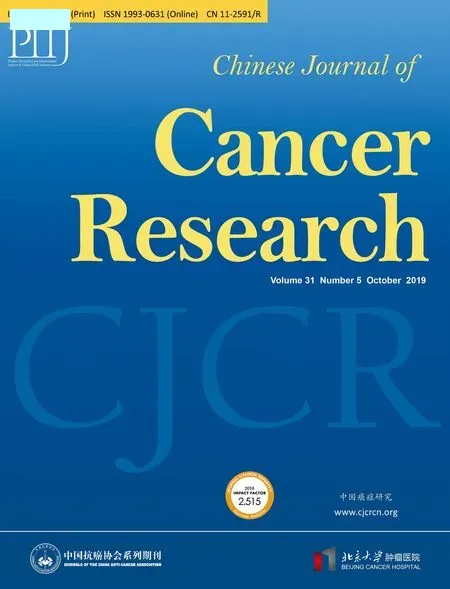 Chinese Journal of Cancer Research2019年5期
Chinese Journal of Cancer Research2019年5期
- Chinese Journal of Cancer Research的其它文章
- A study on service capacity of primary medical and health institutions for cervical cancer screening in urban and rural areas in China
- Surgical outcomes of hand-assisted laparoscopic liver resection vs.open liver resection:A retrospective propensity scorematched cohort study
- Texture analysis on gadoxetic acid enhanced-MRI for predicting Ki-67 status in hepatocellular carcinoma:A prospective study
- Machine-learning-assisted prediction of surgical outcomes in patients undergoing gastrectomy
- Prognostic significance of lymphovascular infiltration in overall survival of gastric cancer patients after surgery with curative intent
- Phosphoglucose isomerase gene expression as a prognostic biomarker of gastric cancer
